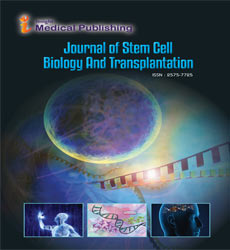ISSN : 2575-7725
Journal of Stem Cell Biology and Transplantation
Human Pluripotent Stem Cell-Derived Cells: A Cell Source for Transplantation
Lili Zhu*
Newcastle University, Institute of Genetic Medicine, International Centre for Life, Central Parkway, Newcastle NE1 3BZ, UK.
- *Corresponding Author:
- Lili Zhu
Newcastle University
Institute of Genetic Medicine
International Centre for Life
Central Parkway
Newcastle NE1 3BZ, UK
Tel: 07478585881
E-mail: lili.zhu@ncl.ac.uk
Received Date: October 07, 2016; Accepted Date: October 17, 2016; Published Date: October 24, 2016
Citation: Zhu L. Human Pluripotent Stem Cell-Derived Cells: A Cell Source for Transplantation. Struct Chem Crystallogr Commun. J. stem cell Bio. transplant. 2016, 1:1.
DOI: 10.21767/2575-7725.100002
Human embryonic stem cells (hES cells) and human induced pluripotent stem cells (hiPS cells) are defined as human pluripotent stem cells [1,2]. They have two unique properties: unlimited selfrenewal and pluripotency, which made them attractive for human early development research, disease modeling, drug screening and cell replacement [1-4].
The most important potential of hES and hiPS cells is they could be used clinically to develop replacement cells for transplantation medicine for diseases caused by loss of cell or cell function [5-8]. One recent promising progress is the transplantation of RPE cells in human patients [9,10]. The first use of hES cell-derived RPE cells in human patients was described by Schwartz group, in one patient with Stargardt’s macular dystrophy and another with dry AMD. Initial results show no significant improvement in visual function as loss of photoreceptor cells is at an advanced stage, but do suggest a good safety profile [9,10]. A number of clinical trials investigating the safety of ESC-RPE are now underway or planned. The study of transplantation of hiPS-derived RPE sheet in human with exudative age-related macular degeneration is underway in Japan. The first patient receiving transplantation was in September 2014. This is the first human clinical trial to use iPS-derived cells. The outcomes of this trial are anxiously awaited.
These promising applications of hES cells and hiPS cells have opened exciting avenues for regenerative medicine, disease modelling and drug screening. To harshness these potentials, we need to further understand the fundamental mechanisms of hES/hiPS cells self-renewal, pluripotency, disease mechanism and clinical trial in order to manipulate the process and improve the quality, efficiency, accuracy and consistency of generating target cells.
- Thomson JA, Itskovitz-Eldor J, Shapiro SS, Waknitz MA, Swiergiel JJ, et al. (1998) Embryonic stem cell lines derived from human blastocysts. Science 282: 1145-1147.
- Takahashi K, Yamanaka S (2006) Induction of pluripotent stem cells from mouse embryonic and adult fibroblast cultures by defined factors. Cell 126: 663-676.
- Heins N, Englund Mikael CO, Sjöblom C, Dahl Ulf, Tonning A, et al. (2004) Derivation, characterization, and differentiation of human embryonic stem cells. Stem Cells 22: 367-376.
- Yu J, Hu K, Smuga-Otto K, Tian S, Stewart R, et al. (2009) Human induced pluripotent stem cells free of vector and transgene sequences. Science 324: 797-801.
- Yoshida Y, Yamanaka S (2011) iPS cells: a source of cardiac regeneration. Journal of molecular and cellular cardiology 50: 327-332.
- Takahashi K, Yamanaka S (2013) Induced pluripotent stem cells in medicine and biology. Development 140: 2457-2461.
- Hanna J, Wernig M, Markoulaki S, Sun CW, Meissner A, et al. (2007) Treatment of sickle cell anemia mouse model with iPS cells generated from autologous skin. Science 318: 1920-1923.
- Wernig M, Zhao JP, Pruszak J, Hedlund E, Fu D, et al. (2008) Neurons derived from reprogrammed fibroblasts functionally integrate into the fetal brain and improve symptoms of rats with Parkinson's disease. Proceedings of the National Academy of Sciences of the United States of America 105: 5856-5861.
- Lu B, Malcuit C, Wang S, Girman S, Francis P, et al. (2009) Long-term safety and function of RPE from human embryonic stem cells in preclinical models of macular degeneration. Stem Cells 27: 2126-2135.
- Schwartz SD, Hubschman JP, Heilwell G, Franco-Cardenas V, Pan CK, et al. (2012) Embryonic stem cell trials for macular degeneration: a preliminary report. Lancet 379: 713-720.
Open Access Journals
- Aquaculture & Veterinary Science
- Chemistry & Chemical Sciences
- Clinical Sciences
- Engineering
- General Science
- Genetics & Molecular Biology
- Health Care & Nursing
- Immunology & Microbiology
- Materials Science
- Mathematics & Physics
- Medical Sciences
- Neurology & Psychiatry
- Oncology & Cancer Science
- Pharmaceutical Sciences
